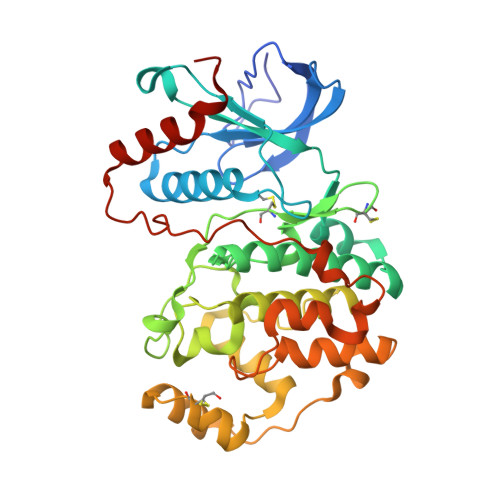A natural small molecule, catechol, induces c-Myc degradation by directly targeting ERK2 in lung cancer.
Lim do, Y., Shin, S.H., Lee, M.H., Malakhova, M., Kurinov, I., Wu, Q., Xu, J., Jiang, Y., Dong, Z., Liu, K., Lee, K.Y., Bae, K.B., Choi, B.Y., Deng, Y., Bode, A., Dong, Z.(2016) Oncotarget 7: 35001-35014
- PubMed: 27167001
- DOI: https://doi.org/10.18632/oncotarget.9223
- Primary Citation of Related Structures:
4ZXT - PubMed Abstract:
Various carcinogens induce EGFR/RAS/MAPK signaling, which is critical in the development of lung cancer. In particular, constitutive activation of extracellular signal-regulated kinase 2 (ERK2) is observed in many lung cancer patients, and therefore developing compounds capable of targeting ERK2 in lung carcinogenesis could be beneficial. We examined the therapeutic effect of catechol in lung cancer treatment. Catechol suppressed anchorage-independent growth of murine KP2 and human H460 lung cancer cell lines in a dose-dependent manner. Catechol inhibited ERK2 kinase activity in vitro, and its direct binding to the ERK2 active site was confirmed by X-ray crystallography. Phosphorylation of c-Myc, a substrate of ERK2, was decreased in catechol-treated lung cancer cells and resulted in reduced protein stability and subsequent down-regulation of total c-Myc. Treatment with catechol induced G1 phase arrest in lung cancer cells and decreased protein expression related to G1-S progression. In addition, we showed that catechol inhibited the growth of both allograft and xenograft lung cancer tumors in vivo. In summary, catechol exerted inhibitory effects on the ERK2/c-Myc signaling axis to reduce lung cancer tumor growth in vitro and in vivo, including a preclinical patient-derived xenograft (PDX) model. These findings suggest that catechol, a natural small molecule, possesses potential as a novel therapeutic agent against lung carcinogenesis in future clinical approaches.
- The Hormel Institute, University of Minnesota, MN, USA.
Organizational Affiliation:




















